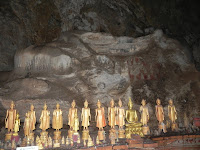



Sabaidee! (“Hello” in Lao) Today we had a long (as in 8 hours) ride down the Mekong from Pakbeng to Luang Prabang. We left Pakbeng at 8 AM and arrived in Luang Prabang about 5:15. The scenery along the way was beautiful. Majestic mountains dotted with the resting huts of the villagers who cultivate the sides of the mountains growing rice, corn and bananas. Even though it is the rainy season and therefore very cloudy the clouds hitting the tops of the mountains were beautiful to see. The first half of the day was very relaxing as we drifted along the river not seeing many other boats. The occasional speedboat would whizz by on its way to Luang Prabang (not the comfortable way to travel that distance if you could see how small those speedboats are!) and occasionally we saw a local fisherman out in his longboat but mostly we had the river to ourselves. We had a Lao language lesson with our guide for part of the morning so that we could learn the basic phrases we need to meet and greet the Lao people we are meeting along the way. Then we all had time to simply relax, read, take naps and enjoy the scenery. We had lunch on the boat again. Delicious Laotian food prepared by the family who owned the boat.
After lunch we made two stops. The first was to a Kamu village. The Kamu are “Upland Lao” peoples, one of the three minorities in Laos. There are the highland Lao (Hmong), the Upland Lao (Kamu) and the lowland Lao people (those who live in Luang Prabang and other cities). This was a riverside village, very tiny. Bamboo houses built on stilts, dirt paths through the village. There was a Buddhist temple there with a few monks even though the Kamu people are not Buddhist. Apparently the temple was there before this tribe settled its village there and they simply allowed the temple to stay and the monks to be part of their village life. We stopped at a basket weaving hut for our younger members to learn how to weave bamboo baskets. The Laotian people use the baskets to cook and serve their “sticky rice” a food staple of their diet. We also visited their rice fields and learned how rice is grown and observed a water buffalo hard at work tilling a rice paddy preparing it for planting. Then we went to the school where there are four classrooms for the village children. The children are out for the summer but in our honor they all gathered at the school to meet us and one of the village teachers was there as well to tell us about the schooling the children receive. The children in these villages are absolutely beautiful. One little fellow met us the minute we arrived and he scampered along with us through our entire tour. We called him our little shadow. He even came down to the river’s edge and sat and watched our boat pull away. I’ve included a picture of him. He’s the one in the long black t-shirt. We put our Lao language lesson into practice with the children, exchanging simple greetings and practicing our Lao on them. They found it highly amusing, I think. In the upper elementary age room, the children sang us a version of Frere Jacques and we all joined in. Then we sang the “ABC” song for them which amused them too. Their teacher is a member of the tribe and she was selected by the village elder to go on to university so that she could come back to teach the village children. She got her education for free (paid for by the village) but in return she has to teach in the village for seven years. The school rooms have no indoor lighting and are therefore pretty dark. They are simple one room cinderblock buildings with desks, a blackboard and chalk as about the sum total of resources available to the teacher.
Then we returned to the boat and continued down the river to our next stop, the Pak Ou caves. These are two caves right in the hillside on the river’s edge where the Lao people come to bring Buddha statues and offer prayers. The lower cave has over 4000 Buddha statues and the upper cave (a long climb up VERY STEEP steps) has about 1500 statues. The upper cave is so huge and dark you need flashlights to navigate inside and even then, it’s hard to see the statues. My pictures show me more of what was there than I could see with my naked eye! The statues and cave are maintained by local monks and villagers come to help the monks maintain the statues, cleaning and bathing them periodically.
We then finished our journey and arrived in Luang Prabang shortly after five in the midst of a heavy downpour. We are staying at the Villa Santi hotel right on the main street in Luang Prabang, which, while one of the major cities of Laos, is really a small town, population about 22,000. The hotel we’re in is gorgeous and we had a wonderful meal in an elegant dining room complete with traditional music accompaniment and classical dancers demonstrating Lao folk dances. We then meandered down to the night market which has every imaginable textile and handicraft of the hill tribe peoples that you could want. We’ll definitely return there before we leave this town! So that’s the report for today. As they say in Laos, pop kan mai (goodnight!)
No comments:
Post a Comment